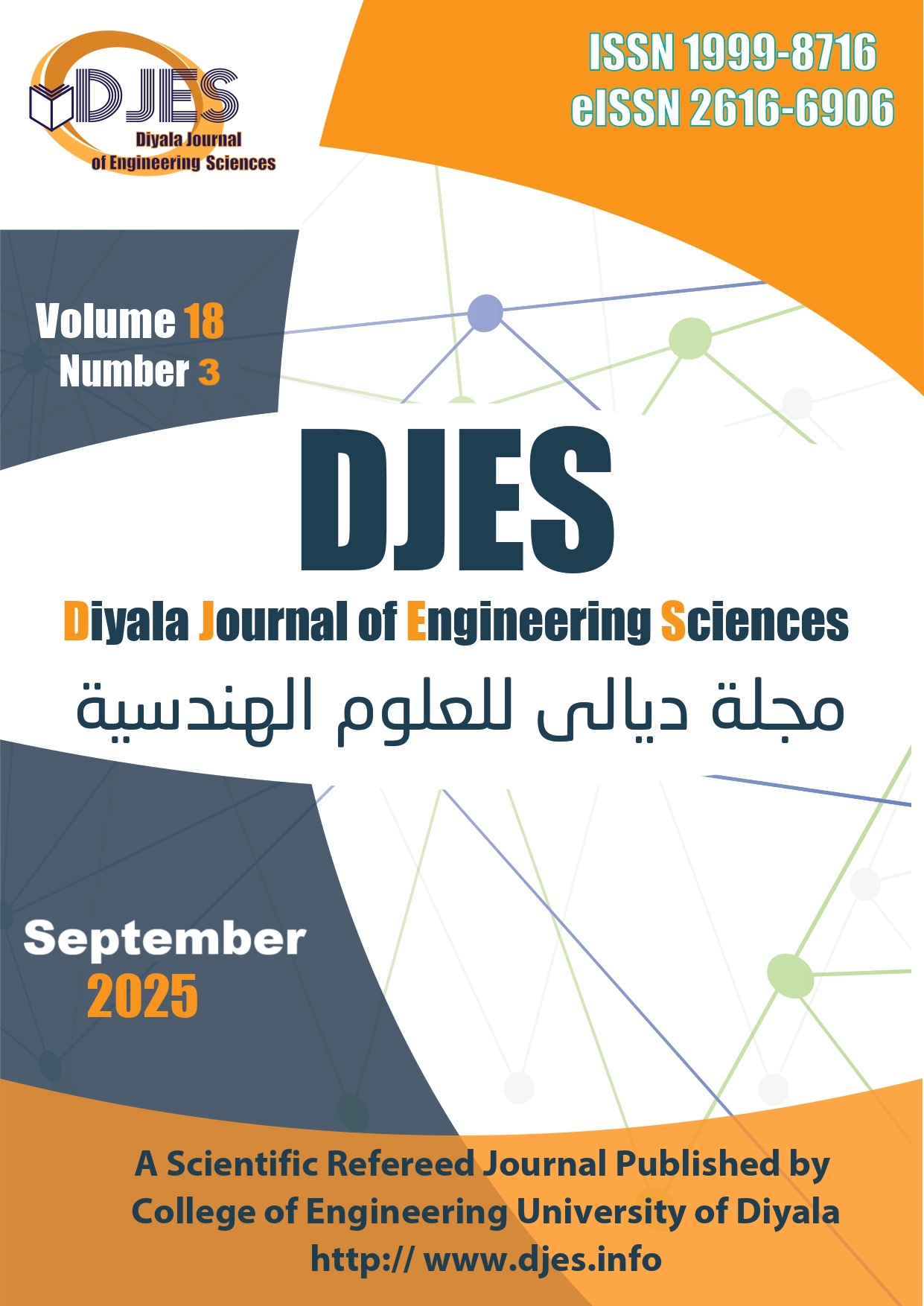Predict settlement of soft clay soil treated with temperature using Deep Neural Network
DOI:
https://doi.org/10.24237/djes.2025.18303Keywords:
Settlement , Soft clay soil, Treated Clay Soil, Deep Neural NetworkAbstract
Many The treatment of soft clay soil at different temperatures substantially influences its settlement properties. Increased temperatures can accelerate the consolidation of soft clay, resulting in alterations in settlement behavior. Estimating the settlement of soft clay soil beneath building foundations is a fundamental aspect of geotechnical engineering design. Traditionally, engineers rely on empirical formulas and classical consolidation theories, such as Terzaghi’s one-dimensional consolidation model, to predict settlement behavior. While these conventional methods provide useful approximations, they often struggle to capture the highly nonlinear and site-specific characteristics of soft clay soils. Recently, artificial intelligence (AI) models, particularly Deep Neural Networks (DNN) and other machine learning algorithms, have emerged as powerful tools for forecasting settlement more accurately. This study applied one of intelligent technique by using deep learning artificial Settlement model (SDNN) model to forecast underground settlement of soft clay soil treated with temperature. DNN model adopted 365 data set, input data parameters such as time period, various of distance between the heaters, temperature and load applied. The outcomes indicate that the SDNN model effectively forecasted ground settlement, showing similar results between actual and predicted values. The performance of the SDNN network model was notably impressive, achieving a mean absolute error (MAE) of 4.3356 % and a mean squared error (MSE) of 0. 4494%. The artificial model also demonstrated strong efficiency and a favorable variance calculation coefficient.
Downloads
References
[1] Kempfert H. G. and Gebreselassie B. Excavations and foundations in soft soils.Springer Science and Business Media, 2006.
[2] Brand E. W. and Breuner R. P. .Soft clay engineering. Elsever scientific published company Amsterdam, 1981.
[3] Qasim A. Aljanabi, Z Chik, A Kasa . "Construction of a new highway embankment on the soft clay soil treatment by stone columns in Malaysia". Journal of Engineering Science and Technology, vol. 8 (4), pp. 448-456.2013.
[4] Das, B.M. . Principles of Geotechnical Engineering. Cengage Learning. Boston, MA, USA, 2019.
[5] Yiyi Wang, Yong Liu , "Research on Thermal Characterization of Soil Heat Transfer in Cross-Seasonal Borehole Thermal Storage Systems", Environmental science and engineering, vol. 1, pp. 321-338, 2024.
[6] D Bennaceur, N Laredj, M Maliki, H Missoum, "Numerical investigation of heat and moisture migration in clayey and sandy soils, exploring seasonal fluctuations", Studies in Engineering and Exact Sciences , vol.5 (2), pp.e8061-e8061, 2024.
[7] Zdankus, T., & Vaiciunas, J., "Experimental Research of the Heat Transfer into the Ground at Relatively High and Low Water Table Levels", Buildings, vol. 13(5), pp.1272, 2023.
[8] QA Aljanabi, Z Chik, MF Allawi, AH El-Shafie, AN Ahmed, A El-Shafie, 'Support vector regression-based model for prediction of behavior stone column parameters in soft clay under highway embankment", Neural Computing and Applications. Vol. 30, pp. 2459-246938, 2018.
[9] Johari A, Javadi AA, Najafi H. A genetic-based model to predict maximum lateral displacement of retaining wall in granular soil. Sci Iran. 2016;23:54–65. https:// doi. org/ 10. 24200/ sci. 2016. 2097.
[10] Shahin MA, Jaska MB, Maier HR 'Predicting settlement of shallow foundation using neural networks', J Geotech Geoenviron Eng (ASCE) , vol.128(9), pp.785–793, 2002.
[11] Kim, M., Senturk, M. A., Tan, R. K., Ordu, E., & Ko, J. . Deep Learning Approach on Prediction of Soil Consolidation Characteristics. Buildings. 2024. https://doi.org/10.3390/buildings14020450
[12] Kim, S., Kim, J. W., Kim, T., & Jung, J.-H. . A Hierarchical Gated Recurrent Unit Network Model for Settlement Prediction. 2023. https://doi.org/10.1145/3599957.3606246
[13] Gong, W., Zuo, L., Li, L., & Wang, H. . Prediction of stratified ground consolidation via a physics‐informed neural network utilizing short‐term excess pore water pressure monitoring data. Computer-Aided Civil and Infrastructure Engineering. 2024. https://doi.org/10.1111/mice.13326
[14] Cao, Y., Zhou, X., Yan, K., & Yan, K. . Deep Learning Neural Network Model for Tunnel Ground Surface Settlement Prediction Based on Sensor Data. Mathematical Problems in Engineering, 2021, 1–14. 2021. https://doi.org/10.1155/2021/9488892
[15] Kanayama, M., Rohe, A., & van Paassen, L. A. . Using and Improving Neural Network Models for Ground Settlement Prediction. Geotechnical and Geological Engineering, 32(3), 687–697. 2014. https://doi.org/10.1007/S10706-014-9745-8
[16] Naeini, S.A., Moayed, R.Z., Kordnaeij, A., Mola-Abasi, H. "Elasticity modulus of clayey deposits estimation using group method of data handling type neural network", Measurement, vol.121, pp.335–343, 2018.
[17] DM Hanoon, QA Aljanabi, "Experimental study on soft clay soils to improve settlement and ultimate stress using thermos mechanical loads". Proceedings on Engineering vol.5 (3), pp. 525-538,2024.
[18] QA Aljanabi , "SOFT Ground subsidence prediction of highway based on the BP neural network" Diyala Journal Of Engineering Sciences, vol. 8 (4) pp 183-188, 2015
[19] Géron, A. . Hands-On Machine Learning with Scikit-Learn, Keras, and TensorFlow (3rd ed.). O'Reilly,2022.
[20] Kelleher, J.D., Mac Namee, B., & D'Arcy, A.. Fundamentals of Machine Learning for Predictive Data Analytics (2nd ed.). MIT Press. 2020.
[21] Z Chik, QA Aljanabi, A Kasa, MR Taha ,"Tenfold cross validation artificial neural network modeling of the settlement behavior of a stone column under a highway embankment". Arabian Journal of Geosciences, vol. 7, 4877-4887, 2014.
[22] Sohail, A., Watanabe, K. and Takeuchi, S. , “Runoff analysis for a small watershed of Tono area Japan by back propagation Artificial Neural Network with seasonal data”, Water Resour Manage, pp.1–22. 2008.
Downloads
Published
Issue
Section
License
Copyright (c) 2025 Qasim A. Aljanabi, Saad Sh. Sammen, Ozgur Kisi

This work is licensed under a Creative Commons Attribution 4.0 International License.












